Business Law Report: UK Sales, Credit, and Intellectual Property Law
VerifiedAdded on 2020/06/03
|16
|5684
|37
Report
AI Summary
This report provides a comprehensive overview of various aspects of business law in the UK. It begins with an analysis of the Sales of Goods Act 1979, examining implied terms, statutory provisions on the transfer of property, and remedies for both buyers and sellers. The report then delves into product liability rules and regulations, including defective goods and the Consumer Protection Act. Furthermore, it explores different types of credit agreements and their legal implications, alongside the characteristics, rights, and duties of agents. The report also addresses anti-competitive practice legislation in the UK, the role of the Competition Commission, and exemptions. Finally, it covers different forms of intellectual property, including patents, copyrights, trademarks, and business names, discussing their protection and infringement. The report uses real-world scenarios, such as a car purchase gone wrong, to illustrate the practical application of legal principles.
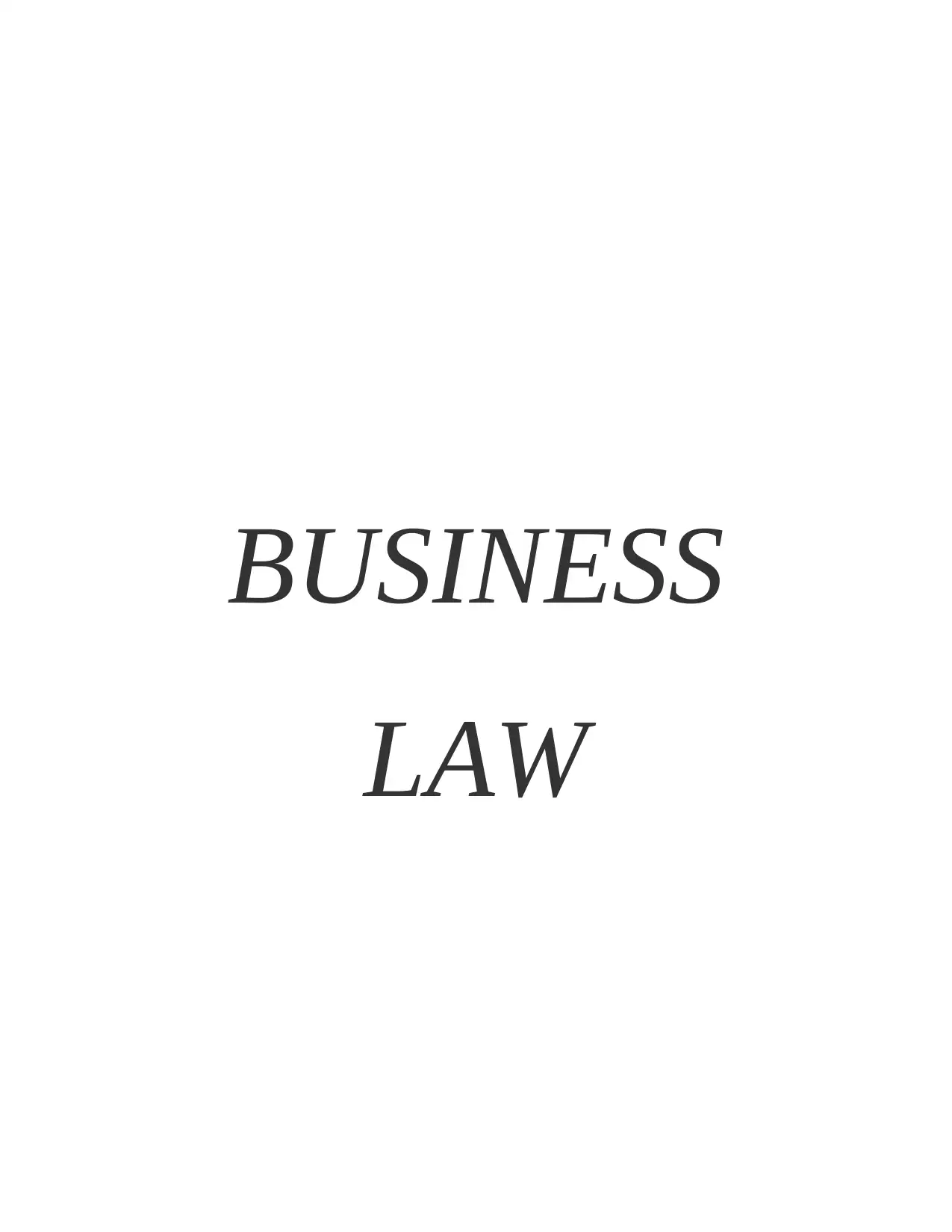
BUSINESS
LAW
LAW
Paraphrase This Document
Need a fresh take? Get an instant paraphrase of this document with our AI Paraphraser
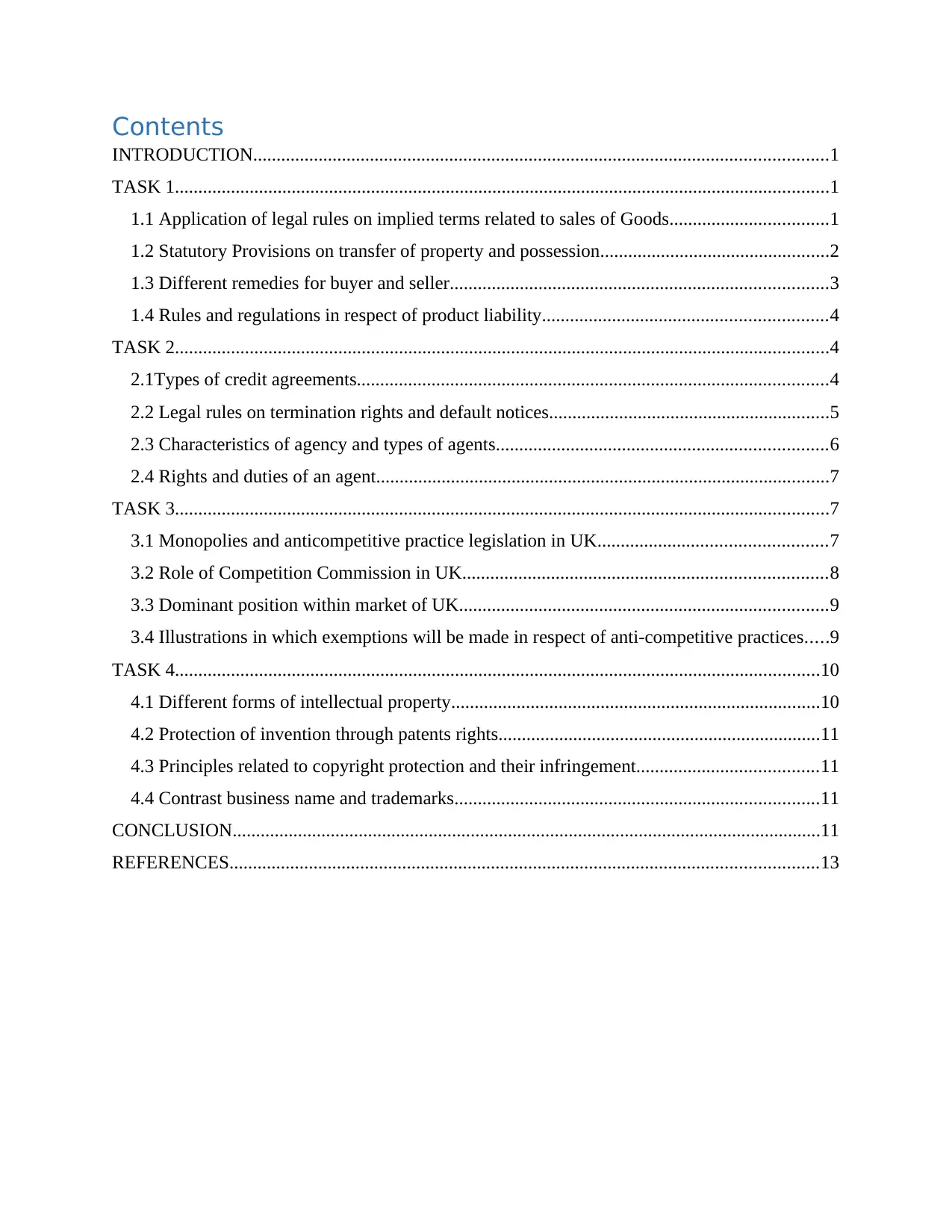
Contents
INTRODUCTION...........................................................................................................................1
TASK 1............................................................................................................................................1
1.1 Application of legal rules on implied terms related to sales of Goods..................................1
1.2 Statutory Provisions on transfer of property and possession.................................................2
1.3 Different remedies for buyer and seller.................................................................................3
1.4 Rules and regulations in respect of product liability.............................................................4
TASK 2............................................................................................................................................4
2.1Types of credit agreements.....................................................................................................4
2.2 Legal rules on termination rights and default notices............................................................5
2.3 Characteristics of agency and types of agents.......................................................................6
2.4 Rights and duties of an agent.................................................................................................7
TASK 3............................................................................................................................................7
3.1 Monopolies and anticompetitive practice legislation in UK.................................................7
3.2 Role of Competition Commission in UK..............................................................................8
3.3 Dominant position within market of UK...............................................................................9
3.4 Illustrations in which exemptions will be made in respect of anti-competitive practices.....9
TASK 4..........................................................................................................................................10
4.1 Different forms of intellectual property...............................................................................10
4.2 Protection of invention through patents rights.....................................................................11
4.3 Principles related to copyright protection and their infringement.......................................11
4.4 Contrast business name and trademarks..............................................................................11
CONCLUSION..............................................................................................................................11
REFERENCES..............................................................................................................................13
INTRODUCTION...........................................................................................................................1
TASK 1............................................................................................................................................1
1.1 Application of legal rules on implied terms related to sales of Goods..................................1
1.2 Statutory Provisions on transfer of property and possession.................................................2
1.3 Different remedies for buyer and seller.................................................................................3
1.4 Rules and regulations in respect of product liability.............................................................4
TASK 2............................................................................................................................................4
2.1Types of credit agreements.....................................................................................................4
2.2 Legal rules on termination rights and default notices............................................................5
2.3 Characteristics of agency and types of agents.......................................................................6
2.4 Rights and duties of an agent.................................................................................................7
TASK 3............................................................................................................................................7
3.1 Monopolies and anticompetitive practice legislation in UK.................................................7
3.2 Role of Competition Commission in UK..............................................................................8
3.3 Dominant position within market of UK...............................................................................9
3.4 Illustrations in which exemptions will be made in respect of anti-competitive practices.....9
TASK 4..........................................................................................................................................10
4.1 Different forms of intellectual property...............................................................................10
4.2 Protection of invention through patents rights.....................................................................11
4.3 Principles related to copyright protection and their infringement.......................................11
4.4 Contrast business name and trademarks..............................................................................11
CONCLUSION..............................................................................................................................11
REFERENCES..............................................................................................................................13
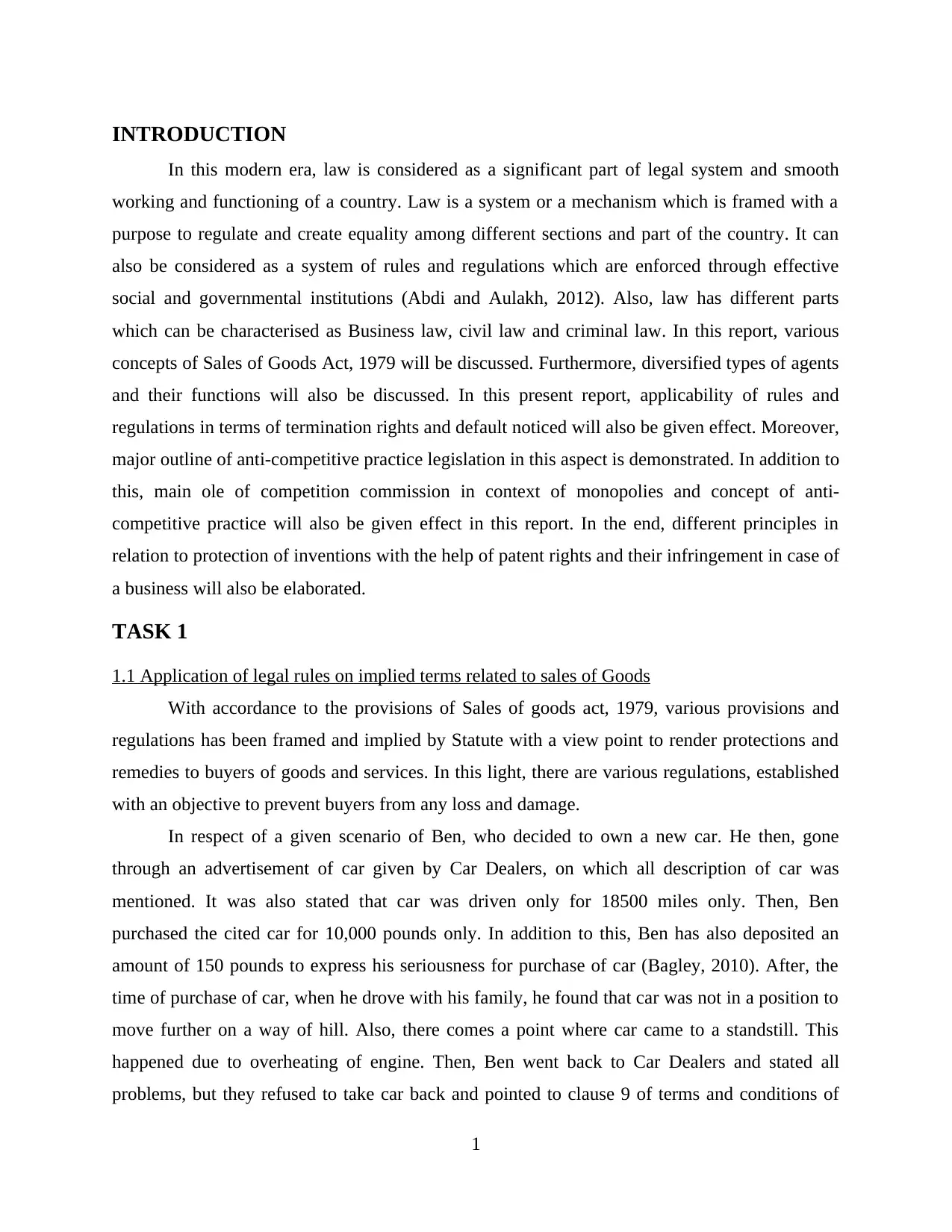
INTRODUCTION
In this modern era, law is considered as a significant part of legal system and smooth
working and functioning of a country. Law is a system or a mechanism which is framed with a
purpose to regulate and create equality among different sections and part of the country. It can
also be considered as a system of rules and regulations which are enforced through effective
social and governmental institutions (Abdi and Aulakh, 2012). Also, law has different parts
which can be characterised as Business law, civil law and criminal law. In this report, various
concepts of Sales of Goods Act, 1979 will be discussed. Furthermore, diversified types of agents
and their functions will also be discussed. In this present report, applicability of rules and
regulations in terms of termination rights and default noticed will also be given effect. Moreover,
major outline of anti-competitive practice legislation in this aspect is demonstrated. In addition to
this, main ole of competition commission in context of monopolies and concept of anti-
competitive practice will also be given effect in this report. In the end, different principles in
relation to protection of inventions with the help of patent rights and their infringement in case of
a business will also be elaborated.
TASK 1
1.1 Application of legal rules on implied terms related to sales of Goods
With accordance to the provisions of Sales of goods act, 1979, various provisions and
regulations has been framed and implied by Statute with a view point to render protections and
remedies to buyers of goods and services. In this light, there are various regulations, established
with an objective to prevent buyers from any loss and damage.
In respect of a given scenario of Ben, who decided to own a new car. He then, gone
through an advertisement of car given by Car Dealers, on which all description of car was
mentioned. It was also stated that car was driven only for 18500 miles only. Then, Ben
purchased the cited car for 10,000 pounds only. In addition to this, Ben has also deposited an
amount of 150 pounds to express his seriousness for purchase of car (Bagley, 2010). After, the
time of purchase of car, when he drove with his family, he found that car was not in a position to
move further on a way of hill. Also, there comes a point where car came to a standstill. This
happened due to overheating of engine. Then, Ben went back to Car Dealers and stated all
problems, but they refused to take car back and pointed to clause 9 of terms and conditions of
1
In this modern era, law is considered as a significant part of legal system and smooth
working and functioning of a country. Law is a system or a mechanism which is framed with a
purpose to regulate and create equality among different sections and part of the country. It can
also be considered as a system of rules and regulations which are enforced through effective
social and governmental institutions (Abdi and Aulakh, 2012). Also, law has different parts
which can be characterised as Business law, civil law and criminal law. In this report, various
concepts of Sales of Goods Act, 1979 will be discussed. Furthermore, diversified types of agents
and their functions will also be discussed. In this present report, applicability of rules and
regulations in terms of termination rights and default noticed will also be given effect. Moreover,
major outline of anti-competitive practice legislation in this aspect is demonstrated. In addition to
this, main ole of competition commission in context of monopolies and concept of anti-
competitive practice will also be given effect in this report. In the end, different principles in
relation to protection of inventions with the help of patent rights and their infringement in case of
a business will also be elaborated.
TASK 1
1.1 Application of legal rules on implied terms related to sales of Goods
With accordance to the provisions of Sales of goods act, 1979, various provisions and
regulations has been framed and implied by Statute with a view point to render protections and
remedies to buyers of goods and services. In this light, there are various regulations, established
with an objective to prevent buyers from any loss and damage.
In respect of a given scenario of Ben, who decided to own a new car. He then, gone
through an advertisement of car given by Car Dealers, on which all description of car was
mentioned. It was also stated that car was driven only for 18500 miles only. Then, Ben
purchased the cited car for 10,000 pounds only. In addition to this, Ben has also deposited an
amount of 150 pounds to express his seriousness for purchase of car (Bagley, 2010). After, the
time of purchase of car, when he drove with his family, he found that car was not in a position to
move further on a way of hill. Also, there comes a point where car came to a standstill. This
happened due to overheating of engine. Then, Ben went back to Car Dealers and stated all
problems, but they refused to take car back and pointed to clause 9 of terms and conditions of
1
⊘ This is a preview!⊘
Do you want full access?
Subscribe today to unlock all pages.

Trusted by 1+ million students worldwide

agreement which stated, that seller has no responsibility in case of any damage or loss. It’s a duty
of buyer to make its own independent checks.
So, in this light, Ben is left with various legal provisions of Sales of Goods act, 1979,
which are elaborated as: In accordance with Section 12(1), seller has been provided with a right to sell goods and
services. These can also be considered as a condition (Bishara, 2011).
Section 12(2), implies a concept, that goods and services sold, should be free from all
sorts of encumbrances and undisclosed charge. In view point of Section 13(1), in case of any agreement or contract framed in relation to
sale of goods and services, there is an implied condition that good should be in
accordance with description made in regard to it. In reference to this, a landmark case law
of “Harlington & Leinster v Christopher Hull Fine Art [1991] 1 QB 564” has been
established.
Section 14 of said act, ensures that goods and services should be fit and according to
quality described in advertisement. These should be of satisfactory quality. In addition to
this, all goods and services sold by seller should be burden free.
Hence, Ben has been provided with various aforementioned legal rules and regulations in
relation to sale of goods and services.
1.2 Statutory Provisions on transfer of property and possession
There are several statutory norms and regulations framed with an objective to effect
transfer of property and possession. Car dealer has sold wrong car to Ben and also assumes no
responsibility in further (Cheeseman and Garvey, 2014). In this case, Ben can be advised on
various regulations which can be elaborated as:
Goods should be ascertained: It includes a proviso that, in a contract made in between
two persons, goods should be clearly ascertained in said agreement of sale, else, it will
not be able to be transferred to buyer. So, in case of an agreement between Ben and Car
Dealers, description of car should be ascertained in an effective manner.
Intention of parties: In this contract of sale, intention of parties must be clearly stated
and determined. With reference to the case law of “Rowland v Divall [1923] 2 KB 500”
it was being held that the parties must clarify their intention to enter into contractual
relationship for sale of goods.
2
of buyer to make its own independent checks.
So, in this light, Ben is left with various legal provisions of Sales of Goods act, 1979,
which are elaborated as: In accordance with Section 12(1), seller has been provided with a right to sell goods and
services. These can also be considered as a condition (Bishara, 2011).
Section 12(2), implies a concept, that goods and services sold, should be free from all
sorts of encumbrances and undisclosed charge. In view point of Section 13(1), in case of any agreement or contract framed in relation to
sale of goods and services, there is an implied condition that good should be in
accordance with description made in regard to it. In reference to this, a landmark case law
of “Harlington & Leinster v Christopher Hull Fine Art [1991] 1 QB 564” has been
established.
Section 14 of said act, ensures that goods and services should be fit and according to
quality described in advertisement. These should be of satisfactory quality. In addition to
this, all goods and services sold by seller should be burden free.
Hence, Ben has been provided with various aforementioned legal rules and regulations in
relation to sale of goods and services.
1.2 Statutory Provisions on transfer of property and possession
There are several statutory norms and regulations framed with an objective to effect
transfer of property and possession. Car dealer has sold wrong car to Ben and also assumes no
responsibility in further (Cheeseman and Garvey, 2014). In this case, Ben can be advised on
various regulations which can be elaborated as:
Goods should be ascertained: It includes a proviso that, in a contract made in between
two persons, goods should be clearly ascertained in said agreement of sale, else, it will
not be able to be transferred to buyer. So, in case of an agreement between Ben and Car
Dealers, description of car should be ascertained in an effective manner.
Intention of parties: In this contract of sale, intention of parties must be clearly stated
and determined. With reference to the case law of “Rowland v Divall [1923] 2 KB 500”
it was being held that the parties must clarify their intention to enter into contractual
relationship for sale of goods.
2
Paraphrase This Document
Need a fresh take? Get an instant paraphrase of this document with our AI Paraphraser
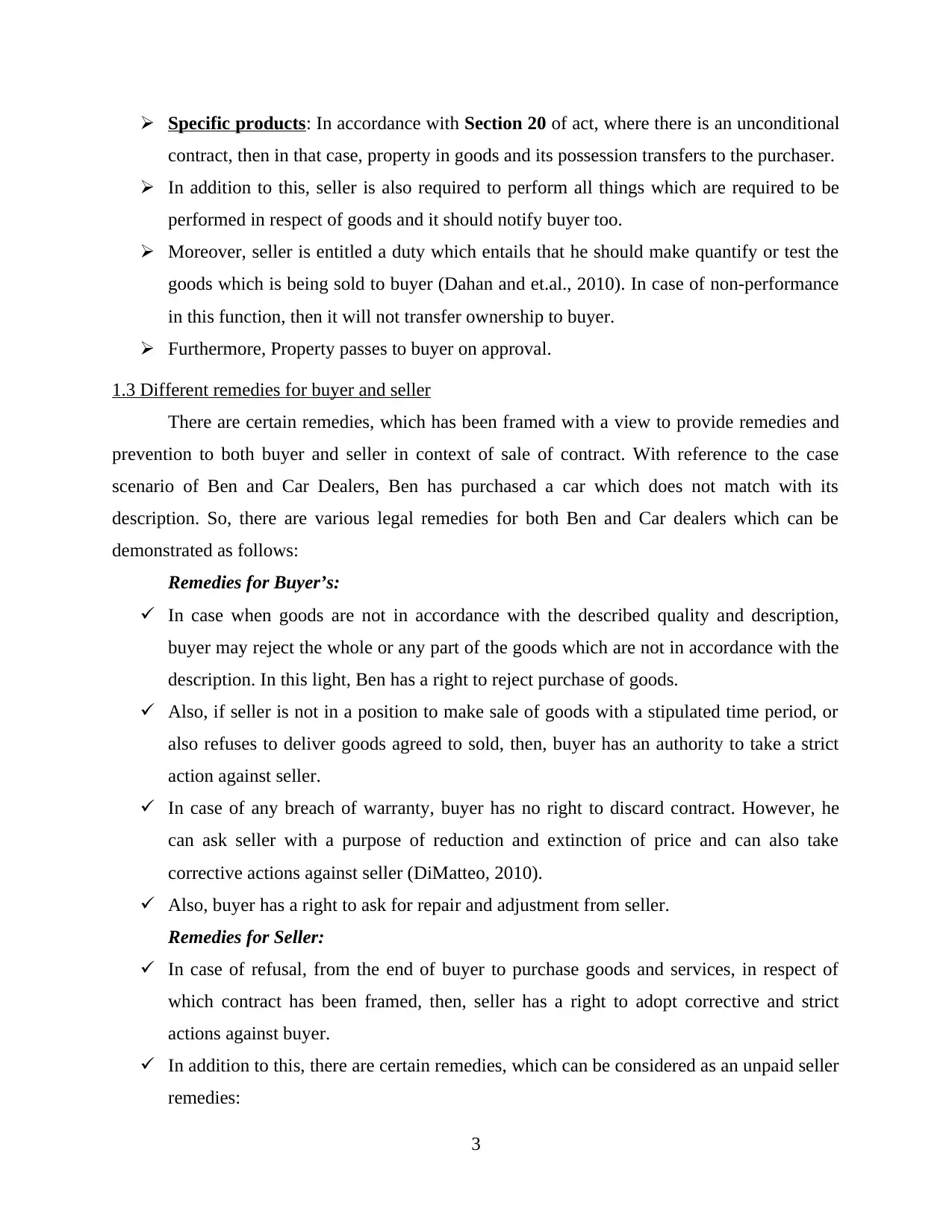
Specific products: In accordance with Section 20 of act, where there is an unconditional
contract, then in that case, property in goods and its possession transfers to the purchaser.
In addition to this, seller is also required to perform all things which are required to be
performed in respect of goods and it should notify buyer too.
Moreover, seller is entitled a duty which entails that he should make quantify or test the
goods which is being sold to buyer (Dahan and et.al., 2010). In case of non-performance
in this function, then it will not transfer ownership to buyer.
Furthermore, Property passes to buyer on approval.
1.3 Different remedies for buyer and seller
There are certain remedies, which has been framed with a view to provide remedies and
prevention to both buyer and seller in context of sale of contract. With reference to the case
scenario of Ben and Car Dealers, Ben has purchased a car which does not match with its
description. So, there are various legal remedies for both Ben and Car dealers which can be
demonstrated as follows:
Remedies for Buyer’s:
In case when goods are not in accordance with the described quality and description,
buyer may reject the whole or any part of the goods which are not in accordance with the
description. In this light, Ben has a right to reject purchase of goods.
Also, if seller is not in a position to make sale of goods with a stipulated time period, or
also refuses to deliver goods agreed to sold, then, buyer has an authority to take a strict
action against seller.
In case of any breach of warranty, buyer has no right to discard contract. However, he
can ask seller with a purpose of reduction and extinction of price and can also take
corrective actions against seller (DiMatteo, 2010).
Also, buyer has a right to ask for repair and adjustment from seller.
Remedies for Seller:
In case of refusal, from the end of buyer to purchase goods and services, in respect of
which contract has been framed, then, seller has a right to adopt corrective and strict
actions against buyer.
In addition to this, there are certain remedies, which can be considered as an unpaid seller
remedies:
3
contract, then in that case, property in goods and its possession transfers to the purchaser.
In addition to this, seller is also required to perform all things which are required to be
performed in respect of goods and it should notify buyer too.
Moreover, seller is entitled a duty which entails that he should make quantify or test the
goods which is being sold to buyer (Dahan and et.al., 2010). In case of non-performance
in this function, then it will not transfer ownership to buyer.
Furthermore, Property passes to buyer on approval.
1.3 Different remedies for buyer and seller
There are certain remedies, which has been framed with a view to provide remedies and
prevention to both buyer and seller in context of sale of contract. With reference to the case
scenario of Ben and Car Dealers, Ben has purchased a car which does not match with its
description. So, there are various legal remedies for both Ben and Car dealers which can be
demonstrated as follows:
Remedies for Buyer’s:
In case when goods are not in accordance with the described quality and description,
buyer may reject the whole or any part of the goods which are not in accordance with the
description. In this light, Ben has a right to reject purchase of goods.
Also, if seller is not in a position to make sale of goods with a stipulated time period, or
also refuses to deliver goods agreed to sold, then, buyer has an authority to take a strict
action against seller.
In case of any breach of warranty, buyer has no right to discard contract. However, he
can ask seller with a purpose of reduction and extinction of price and can also take
corrective actions against seller (DiMatteo, 2010).
Also, buyer has a right to ask for repair and adjustment from seller.
Remedies for Seller:
In case of refusal, from the end of buyer to purchase goods and services, in respect of
which contract has been framed, then, seller has a right to adopt corrective and strict
actions against buyer.
In addition to this, there are certain remedies, which can be considered as an unpaid seller
remedies:
3

o Sellers lien.
o Right to stop goods and services in transit.
o Right to re-sale.
1.4 Rules and regulations in respect of product liability
In accordance with the several provisions of Sales of Goods Act, 1979, there are various
provisions which are instituted with an objective with a purpose of product liability. It can be
evaluated that these provisions arise from Consumer Protection Act (Grundfest, 2010). In view
point of several regulations and norms of Consumer protection act, in case of any defect or loss
in any product or in part of it, then, it will be considered as a liability of manufacturer.
Defective goods: these products are those goods, which are classified as risky products
not only for personal Injury or damage but also for property. Manufacturer of finished product
will be held responsible. In the case of defective car purchased by Ben, manufacturer of cited car
will be held responsible. Also, in case of demanding claim in respect of defective goods, it can
be considered that following conditions must be fulfilled:
Defect is present in product.
Loss or damage has been caused to claimant.
In addition to this, defendant has been declared responsible for defective goods.
In perspective of regulations of Consumer Protection Act, 1987, in aspect to ask for a
claim, buyer has to prove that negligence or breach of contract has been occurred on the part of
seller (King and Raja, 2013). So, if Ben wants to receive claim, then he is required to prove that
Car dealers are on the part of fault. In the case of Liability of Tort, third party has a contractual
right to claim against a person even if there is no relation of contract in between them. Moreover,
in case of “Stevenson v Rogers [1999] 1 All ER 613 Court of Appeal”, it was held that sale
was conducted during business, hence, defendant was under an obligation to sell goods in correct
state, else, plaintiff is entitled to claim against defendant.
TASK 2
2.1Types of credit agreements
There are available several types of agreements, which provides safety and security to
rights of people. The Consumer Credit Act enacted for protect the interest and rights of
4
o Right to stop goods and services in transit.
o Right to re-sale.
1.4 Rules and regulations in respect of product liability
In accordance with the several provisions of Sales of Goods Act, 1979, there are various
provisions which are instituted with an objective with a purpose of product liability. It can be
evaluated that these provisions arise from Consumer Protection Act (Grundfest, 2010). In view
point of several regulations and norms of Consumer protection act, in case of any defect or loss
in any product or in part of it, then, it will be considered as a liability of manufacturer.
Defective goods: these products are those goods, which are classified as risky products
not only for personal Injury or damage but also for property. Manufacturer of finished product
will be held responsible. In the case of defective car purchased by Ben, manufacturer of cited car
will be held responsible. Also, in case of demanding claim in respect of defective goods, it can
be considered that following conditions must be fulfilled:
Defect is present in product.
Loss or damage has been caused to claimant.
In addition to this, defendant has been declared responsible for defective goods.
In perspective of regulations of Consumer Protection Act, 1987, in aspect to ask for a
claim, buyer has to prove that negligence or breach of contract has been occurred on the part of
seller (King and Raja, 2013). So, if Ben wants to receive claim, then he is required to prove that
Car dealers are on the part of fault. In the case of Liability of Tort, third party has a contractual
right to claim against a person even if there is no relation of contract in between them. Moreover,
in case of “Stevenson v Rogers [1999] 1 All ER 613 Court of Appeal”, it was held that sale
was conducted during business, hence, defendant was under an obligation to sell goods in correct
state, else, plaintiff is entitled to claim against defendant.
TASK 2
2.1Types of credit agreements
There are available several types of agreements, which provides safety and security to
rights of people. The Consumer Credit Act enacted for protect the interest and rights of
4
⊘ This is a preview!⊘
Do you want full access?
Subscribe today to unlock all pages.

Trusted by 1+ million students worldwide

consumers, now it become Consumers Act 2006. This act working as like safeguards to the all
rights and powers of consumers, with the help of this legislation for their protection regarding
any breach of agreements and defaults (Kinicki and Kreitner, 2012). In the context of this case,
Ben wants to become car dealer in UK and sell second hand car in external market place. He
wants to search credit card agency and apply consumer credit on it. Ben uses credit to pay
facility in their business, with the assist of this he can take credit from various sources. After that
he become liable to pay interest with principle amount to them in decided time period. There will
be explain different types of credit agency and sources, those all are stated under following:
Hire purchase: This is a legal agreement, in which buyer purchase an item and pay
amount in decided fix instalments. This type of agreement buyer and seller made an legal
contract with each other’s as per their rules and the title of ownership is transferred after
full payment of goods by buyer to seller. Seller has right to taken back from buyer, if
product become default and buyer breach the contract.
Condition sale: It refers to, last time of this contract, buyer has liable to pay full amount
of goods and that contract have to be complete without breached any rules and
regulations. Buyer is under obligation with whole time of agreement.
Credit sale: According to this agreement, buyer become the owner of a particular item.
In which buyer has liable to pay amount for full fill the contact as per their legal rules and
regulations (Mann and Roberts, 2011). After that he has to be pay back entire amount of
money which he taken credit.
2.2 Legal rules on termination rights and default notices
Termination right is a concept which comes into existence in case of end of contract. In
this light, the rights of buyer are considered to be terminated in a case, when buyer and seller is
not entitled for right contract. There are certain rights, which are evolved in case of termination
in case of being as a debtor:
Various circumstances arise in case, when both seller and buyer wants to revoke contract,
before dates of termination of an agreement made in between them (McGill, 2010). In
case of any unfavourable conditions, then, they can modify their terms and agreements as
per their choice.
Also, main reason of creation of termination is non- satisfactory performance of
agreement.
5
rights and powers of consumers, with the help of this legislation for their protection regarding
any breach of agreements and defaults (Kinicki and Kreitner, 2012). In the context of this case,
Ben wants to become car dealer in UK and sell second hand car in external market place. He
wants to search credit card agency and apply consumer credit on it. Ben uses credit to pay
facility in their business, with the assist of this he can take credit from various sources. After that
he become liable to pay interest with principle amount to them in decided time period. There will
be explain different types of credit agency and sources, those all are stated under following:
Hire purchase: This is a legal agreement, in which buyer purchase an item and pay
amount in decided fix instalments. This type of agreement buyer and seller made an legal
contract with each other’s as per their rules and the title of ownership is transferred after
full payment of goods by buyer to seller. Seller has right to taken back from buyer, if
product become default and buyer breach the contract.
Condition sale: It refers to, last time of this contract, buyer has liable to pay full amount
of goods and that contract have to be complete without breached any rules and
regulations. Buyer is under obligation with whole time of agreement.
Credit sale: According to this agreement, buyer become the owner of a particular item.
In which buyer has liable to pay amount for full fill the contact as per their legal rules and
regulations (Mann and Roberts, 2011). After that he has to be pay back entire amount of
money which he taken credit.
2.2 Legal rules on termination rights and default notices
Termination right is a concept which comes into existence in case of end of contract. In
this light, the rights of buyer are considered to be terminated in a case, when buyer and seller is
not entitled for right contract. There are certain rights, which are evolved in case of termination
in case of being as a debtor:
Various circumstances arise in case, when both seller and buyer wants to revoke contract,
before dates of termination of an agreement made in between them (McGill, 2010). In
case of any unfavourable conditions, then, they can modify their terms and agreements as
per their choice.
Also, main reason of creation of termination is non- satisfactory performance of
agreement.
5
Paraphrase This Document
Need a fresh take? Get an instant paraphrase of this document with our AI Paraphraser
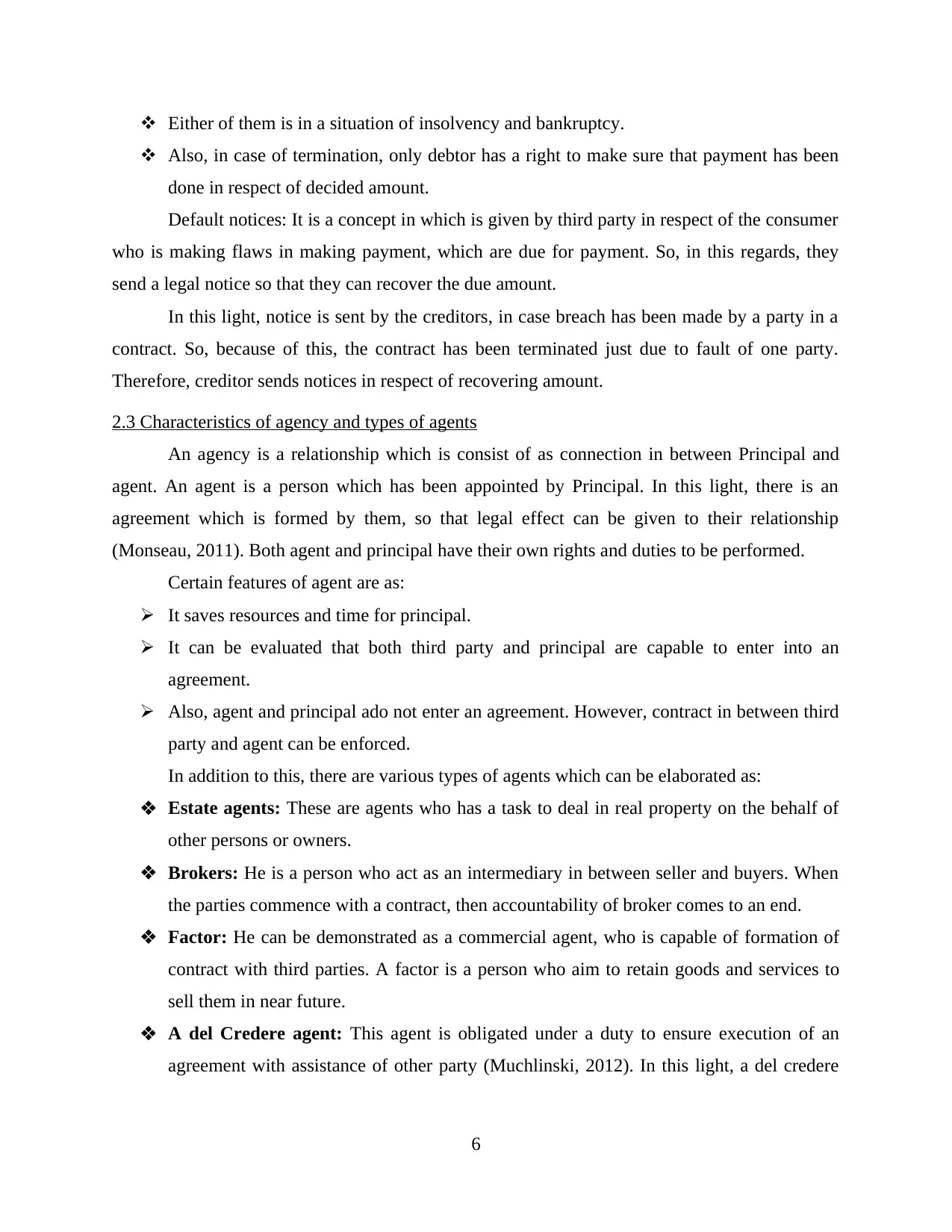
Either of them is in a situation of insolvency and bankruptcy.
Also, in case of termination, only debtor has a right to make sure that payment has been
done in respect of decided amount.
Default notices: It is a concept in which is given by third party in respect of the consumer
who is making flaws in making payment, which are due for payment. So, in this regards, they
send a legal notice so that they can recover the due amount.
In this light, notice is sent by the creditors, in case breach has been made by a party in a
contract. So, because of this, the contract has been terminated just due to fault of one party.
Therefore, creditor sends notices in respect of recovering amount.
2.3 Characteristics of agency and types of agents
An agency is a relationship which is consist of as connection in between Principal and
agent. An agent is a person which has been appointed by Principal. In this light, there is an
agreement which is formed by them, so that legal effect can be given to their relationship
(Monseau, 2011). Both agent and principal have their own rights and duties to be performed.
Certain features of agent are as:
It saves resources and time for principal.
It can be evaluated that both third party and principal are capable to enter into an
agreement.
Also, agent and principal ado not enter an agreement. However, contract in between third
party and agent can be enforced.
In addition to this, there are various types of agents which can be elaborated as:
Estate agents: These are agents who has a task to deal in real property on the behalf of
other persons or owners.
Brokers: He is a person who act as an intermediary in between seller and buyers. When
the parties commence with a contract, then accountability of broker comes to an end.
Factor: He can be demonstrated as a commercial agent, who is capable of formation of
contract with third parties. A factor is a person who aim to retain goods and services to
sell them in near future.
A del Credere agent: This agent is obligated under a duty to ensure execution of an
agreement with assistance of other party (Muchlinski, 2012). In this light, a del credere
6
Also, in case of termination, only debtor has a right to make sure that payment has been
done in respect of decided amount.
Default notices: It is a concept in which is given by third party in respect of the consumer
who is making flaws in making payment, which are due for payment. So, in this regards, they
send a legal notice so that they can recover the due amount.
In this light, notice is sent by the creditors, in case breach has been made by a party in a
contract. So, because of this, the contract has been terminated just due to fault of one party.
Therefore, creditor sends notices in respect of recovering amount.
2.3 Characteristics of agency and types of agents
An agency is a relationship which is consist of as connection in between Principal and
agent. An agent is a person which has been appointed by Principal. In this light, there is an
agreement which is formed by them, so that legal effect can be given to their relationship
(Monseau, 2011). Both agent and principal have their own rights and duties to be performed.
Certain features of agent are as:
It saves resources and time for principal.
It can be evaluated that both third party and principal are capable to enter into an
agreement.
Also, agent and principal ado not enter an agreement. However, contract in between third
party and agent can be enforced.
In addition to this, there are various types of agents which can be elaborated as:
Estate agents: These are agents who has a task to deal in real property on the behalf of
other persons or owners.
Brokers: He is a person who act as an intermediary in between seller and buyers. When
the parties commence with a contract, then accountability of broker comes to an end.
Factor: He can be demonstrated as a commercial agent, who is capable of formation of
contract with third parties. A factor is a person who aim to retain goods and services to
sell them in near future.
A del Credere agent: This agent is obligated under a duty to ensure execution of an
agreement with assistance of other party (Muchlinski, 2012). In this light, a del credere
6
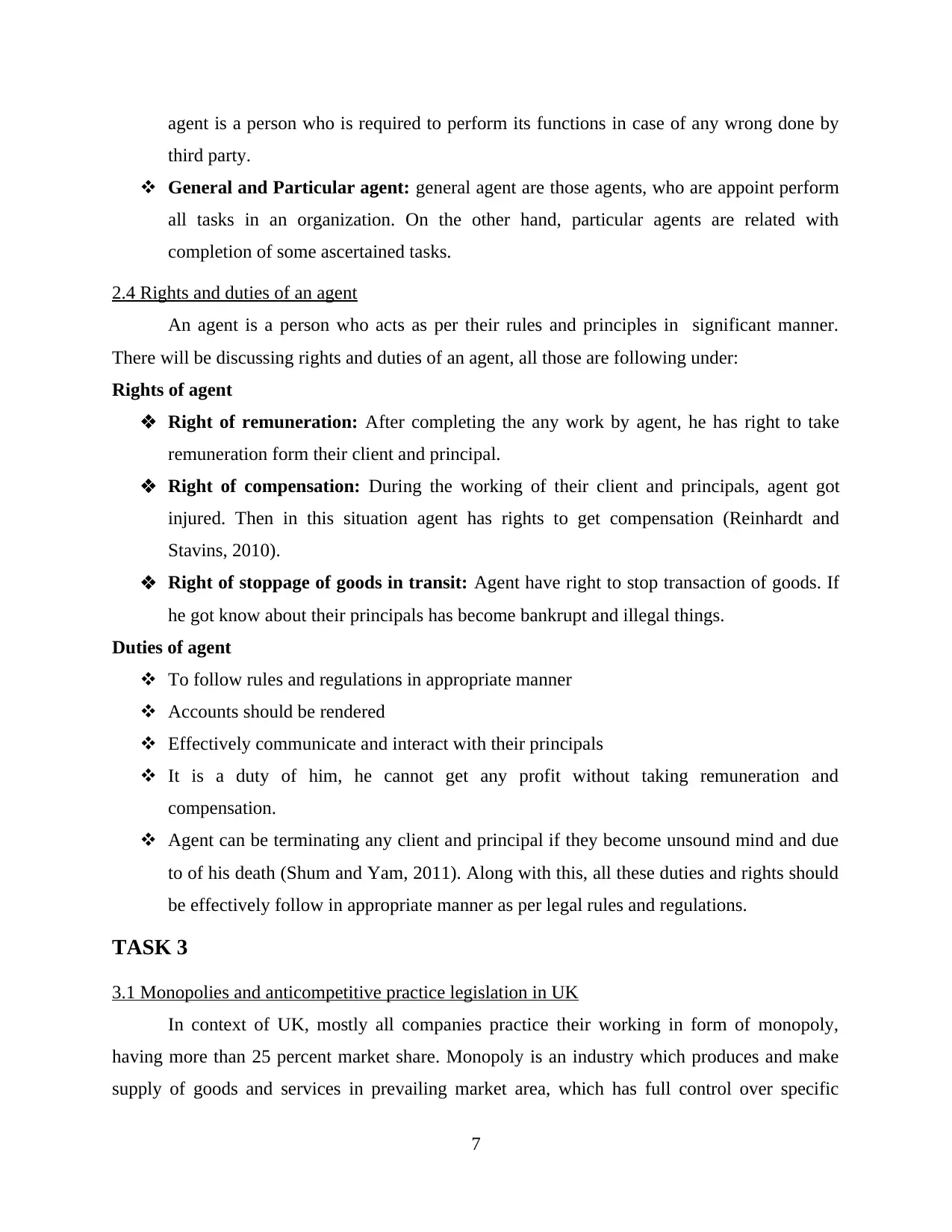
agent is a person who is required to perform its functions in case of any wrong done by
third party.
General and Particular agent: general agent are those agents, who are appoint perform
all tasks in an organization. On the other hand, particular agents are related with
completion of some ascertained tasks.
2.4 Rights and duties of an agent
An agent is a person who acts as per their rules and principles in significant manner.
There will be discussing rights and duties of an agent, all those are following under:
Rights of agent
Right of remuneration: After completing the any work by agent, he has right to take
remuneration form their client and principal.
Right of compensation: During the working of their client and principals, agent got
injured. Then in this situation agent has rights to get compensation (Reinhardt and
Stavins, 2010).
Right of stoppage of goods in transit: Agent have right to stop transaction of goods. If
he got know about their principals has become bankrupt and illegal things.
Duties of agent
To follow rules and regulations in appropriate manner
Accounts should be rendered
Effectively communicate and interact with their principals
It is a duty of him, he cannot get any profit without taking remuneration and
compensation.
Agent can be terminating any client and principal if they become unsound mind and due
to of his death (Shum and Yam, 2011). Along with this, all these duties and rights should
be effectively follow in appropriate manner as per legal rules and regulations.
TASK 3
3.1 Monopolies and anticompetitive practice legislation in UK
In context of UK, mostly all companies practice their working in form of monopoly,
having more than 25 percent market share. Monopoly is an industry which produces and make
supply of goods and services in prevailing market area, which has full control over specific
7
third party.
General and Particular agent: general agent are those agents, who are appoint perform
all tasks in an organization. On the other hand, particular agents are related with
completion of some ascertained tasks.
2.4 Rights and duties of an agent
An agent is a person who acts as per their rules and principles in significant manner.
There will be discussing rights and duties of an agent, all those are following under:
Rights of agent
Right of remuneration: After completing the any work by agent, he has right to take
remuneration form their client and principal.
Right of compensation: During the working of their client and principals, agent got
injured. Then in this situation agent has rights to get compensation (Reinhardt and
Stavins, 2010).
Right of stoppage of goods in transit: Agent have right to stop transaction of goods. If
he got know about their principals has become bankrupt and illegal things.
Duties of agent
To follow rules and regulations in appropriate manner
Accounts should be rendered
Effectively communicate and interact with their principals
It is a duty of him, he cannot get any profit without taking remuneration and
compensation.
Agent can be terminating any client and principal if they become unsound mind and due
to of his death (Shum and Yam, 2011). Along with this, all these duties and rights should
be effectively follow in appropriate manner as per legal rules and regulations.
TASK 3
3.1 Monopolies and anticompetitive practice legislation in UK
In context of UK, mostly all companies practice their working in form of monopoly,
having more than 25 percent market share. Monopoly is an industry which produces and make
supply of goods and services in prevailing market area, which has full control over specific
7
⊘ This is a preview!⊘
Do you want full access?
Subscribe today to unlock all pages.

Trusted by 1+ million students worldwide

market. In this light, in aspect of monopoly market, supplier exploits buying behaviour of
consumer. They charge or incur money in accordance with their own decided rules and
regulations. It can also have considered as a threat to consumer (Ye and et.al., 2011). Also, it can
be said that competition is an element which is seen as a beneficial for consumer.
The competition act has been framed so as to protect anticompetitive practices in two
different manners:
Chap -1 of Competition act 1998, has been framed with a view to prohibit agreement
which is considered as an anticompetitive practice.
Chap -2 of Competitive act, lays down in regard to abuse of dominant position.
Monopoly is a concept which is developed in a market through:
Horizontal merger, that takes place among companies which are under same business
level.
The increased power of one firm which has been gone through its success in product
marketing.
There are various legislations which are established in order to effect anti-competitive
practices in UK, which are as:
Monopolies and Restrictive Practices Act, 1948.
Restrictive Trade practices act, 1956.
Fair trading act, 1973
Competition act, 1980.
3.2 Role of Competition Commission in UK
Competition commission in 7UK was established with a main objective to regulate and
conduct all activities in market area. In addition to this, it is a main regulating and authorised
body, which is consists of various powers (Zumbansen, 2011). In accordance with the policies
and regulations of competition commission of UK, all companies and organizations which
practice monopoly, should be shut down. It mainly focusses on functioning of activities in a fair
manner.
There are various functions of competition commission in diversified range of areas,
which can be demonstrated as:
Competition commission is set up with an aim to create and encourage those practices
which are related with free trade, effective in nature and boosts economic growth.
8
consumer. They charge or incur money in accordance with their own decided rules and
regulations. It can also have considered as a threat to consumer (Ye and et.al., 2011). Also, it can
be said that competition is an element which is seen as a beneficial for consumer.
The competition act has been framed so as to protect anticompetitive practices in two
different manners:
Chap -1 of Competition act 1998, has been framed with a view to prohibit agreement
which is considered as an anticompetitive practice.
Chap -2 of Competitive act, lays down in regard to abuse of dominant position.
Monopoly is a concept which is developed in a market through:
Horizontal merger, that takes place among companies which are under same business
level.
The increased power of one firm which has been gone through its success in product
marketing.
There are various legislations which are established in order to effect anti-competitive
practices in UK, which are as:
Monopolies and Restrictive Practices Act, 1948.
Restrictive Trade practices act, 1956.
Fair trading act, 1973
Competition act, 1980.
3.2 Role of Competition Commission in UK
Competition commission in 7UK was established with a main objective to regulate and
conduct all activities in market area. In addition to this, it is a main regulating and authorised
body, which is consists of various powers (Zumbansen, 2011). In accordance with the policies
and regulations of competition commission of UK, all companies and organizations which
practice monopoly, should be shut down. It mainly focusses on functioning of activities in a fair
manner.
There are various functions of competition commission in diversified range of areas,
which can be demonstrated as:
Competition commission is set up with an aim to create and encourage those practices
which are related with free trade, effective in nature and boosts economic growth.
8
Paraphrase This Document
Need a fresh take? Get an instant paraphrase of this document with our AI Paraphraser
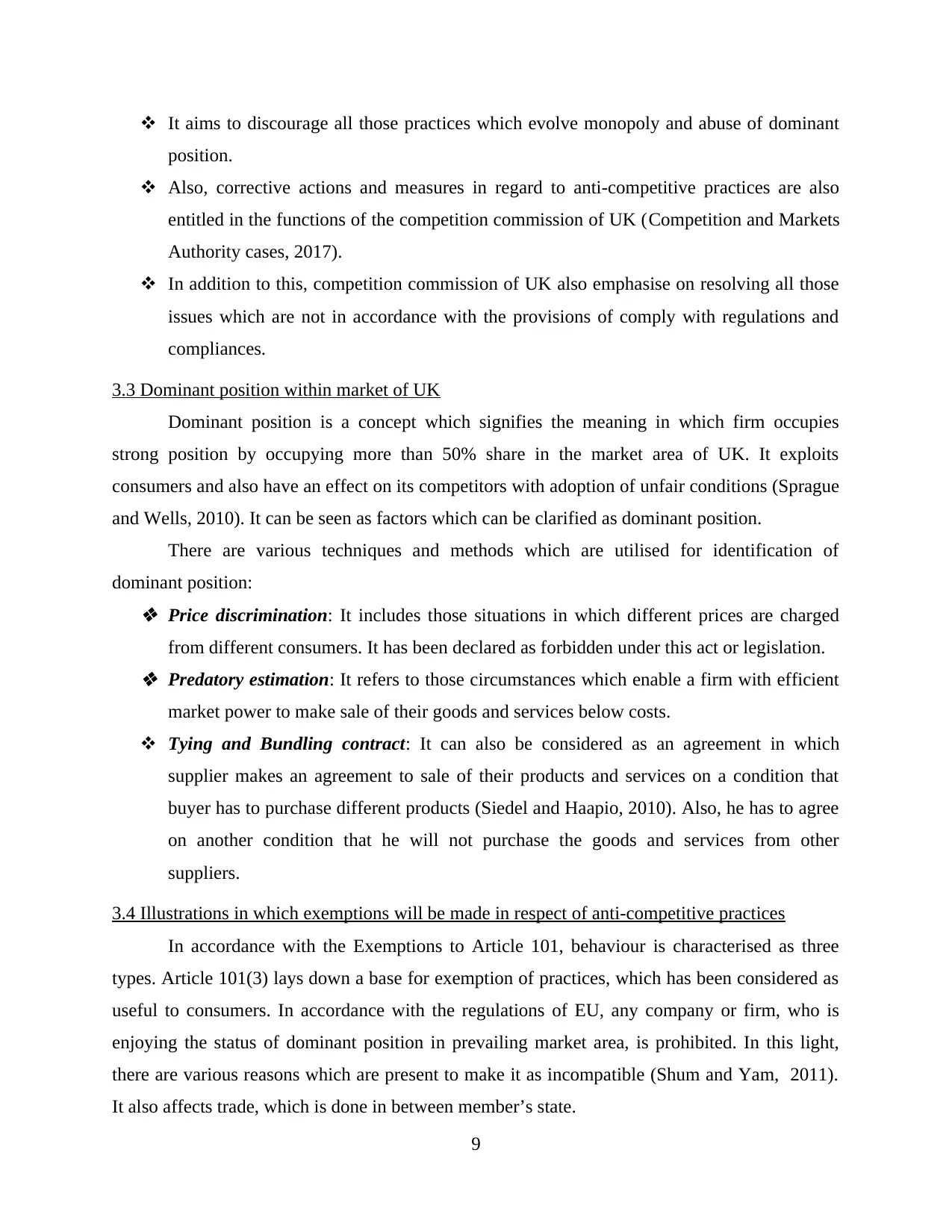
It aims to discourage all those practices which evolve monopoly and abuse of dominant
position.
Also, corrective actions and measures in regard to anti-competitive practices are also
entitled in the functions of the competition commission of UK (Competition and Markets
Authority cases, 2017).
In addition to this, competition commission of UK also emphasise on resolving all those
issues which are not in accordance with the provisions of comply with regulations and
compliances.
3.3 Dominant position within market of UK
Dominant position is a concept which signifies the meaning in which firm occupies
strong position by occupying more than 50% share in the market area of UK. It exploits
consumers and also have an effect on its competitors with adoption of unfair conditions (Sprague
and Wells, 2010). It can be seen as factors which can be clarified as dominant position.
There are various techniques and methods which are utilised for identification of
dominant position: Price discrimination: It includes those situations in which different prices are charged
from different consumers. It has been declared as forbidden under this act or legislation. Predatory estimation: It refers to those circumstances which enable a firm with efficient
market power to make sale of their goods and services below costs.
Tying and Bundling contract: It can also be considered as an agreement in which
supplier makes an agreement to sale of their products and services on a condition that
buyer has to purchase different products (Siedel and Haapio, 2010). Also, he has to agree
on another condition that he will not purchase the goods and services from other
suppliers.
3.4 Illustrations in which exemptions will be made in respect of anti-competitive practices
In accordance with the Exemptions to Article 101, behaviour is characterised as three
types. Article 101(3) lays down a base for exemption of practices, which has been considered as
useful to consumers. In accordance with the regulations of EU, any company or firm, who is
enjoying the status of dominant position in prevailing market area, is prohibited. In this light,
there are various reasons which are present to make it as incompatible (Shum and Yam, 2011).
It also affects trade, which is done in between member’s state.
9
position.
Also, corrective actions and measures in regard to anti-competitive practices are also
entitled in the functions of the competition commission of UK (Competition and Markets
Authority cases, 2017).
In addition to this, competition commission of UK also emphasise on resolving all those
issues which are not in accordance with the provisions of comply with regulations and
compliances.
3.3 Dominant position within market of UK
Dominant position is a concept which signifies the meaning in which firm occupies
strong position by occupying more than 50% share in the market area of UK. It exploits
consumers and also have an effect on its competitors with adoption of unfair conditions (Sprague
and Wells, 2010). It can be seen as factors which can be clarified as dominant position.
There are various techniques and methods which are utilised for identification of
dominant position: Price discrimination: It includes those situations in which different prices are charged
from different consumers. It has been declared as forbidden under this act or legislation. Predatory estimation: It refers to those circumstances which enable a firm with efficient
market power to make sale of their goods and services below costs.
Tying and Bundling contract: It can also be considered as an agreement in which
supplier makes an agreement to sale of their products and services on a condition that
buyer has to purchase different products (Siedel and Haapio, 2010). Also, he has to agree
on another condition that he will not purchase the goods and services from other
suppliers.
3.4 Illustrations in which exemptions will be made in respect of anti-competitive practices
In accordance with the Exemptions to Article 101, behaviour is characterised as three
types. Article 101(3) lays down a base for exemption of practices, which has been considered as
useful to consumers. In accordance with the regulations of EU, any company or firm, who is
enjoying the status of dominant position in prevailing market area, is prohibited. In this light,
there are various reasons which are present to make it as incompatible (Shum and Yam, 2011).
It also affects trade, which is done in between member’s state.
9
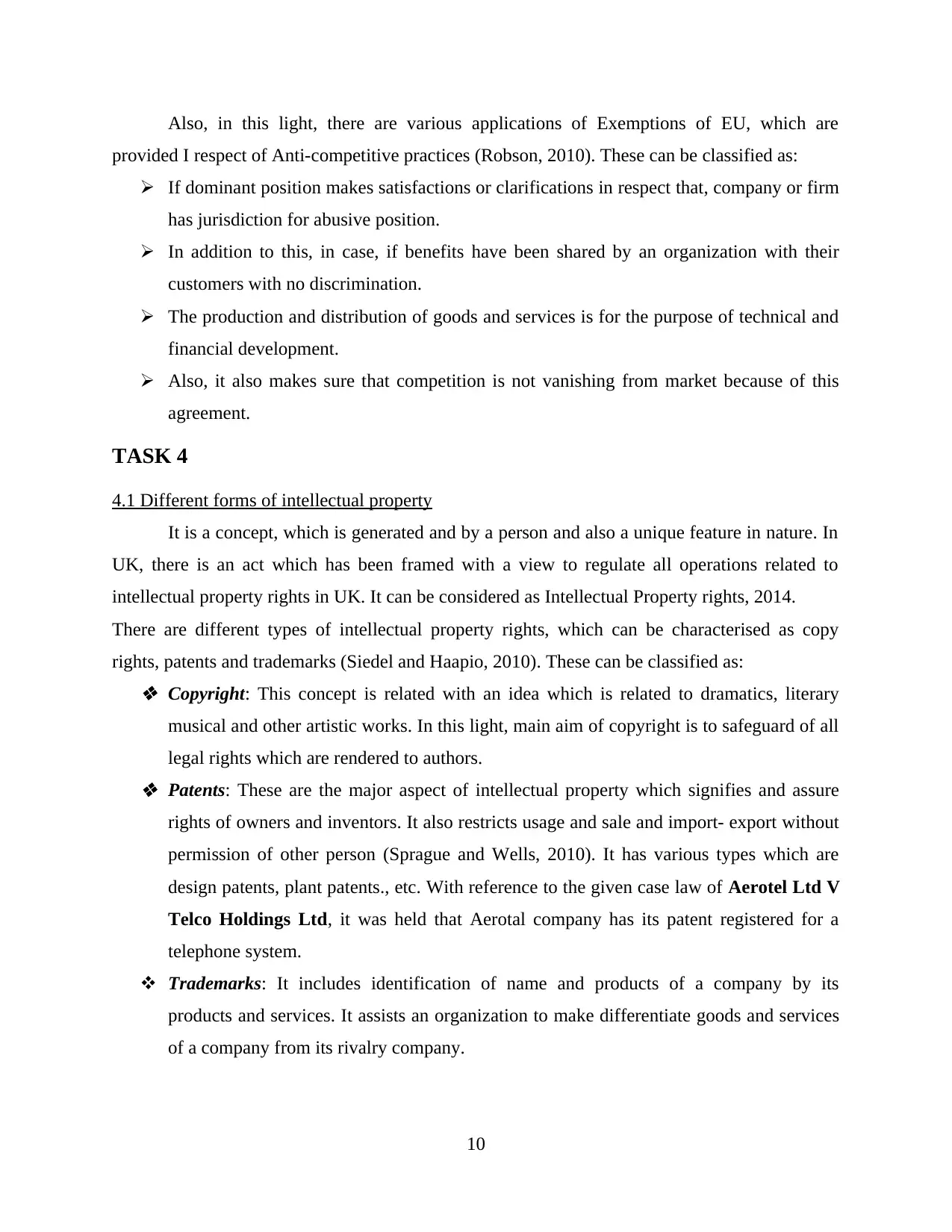
Also, in this light, there are various applications of Exemptions of EU, which are
provided I respect of Anti-competitive practices (Robson, 2010). These can be classified as:
If dominant position makes satisfactions or clarifications in respect that, company or firm
has jurisdiction for abusive position.
In addition to this, in case, if benefits have been shared by an organization with their
customers with no discrimination.
The production and distribution of goods and services is for the purpose of technical and
financial development.
Also, it also makes sure that competition is not vanishing from market because of this
agreement.
TASK 4
4.1 Different forms of intellectual property
It is a concept, which is generated and by a person and also a unique feature in nature. In
UK, there is an act which has been framed with a view to regulate all operations related to
intellectual property rights in UK. It can be considered as Intellectual Property rights, 2014.
There are different types of intellectual property rights, which can be characterised as copy
rights, patents and trademarks (Siedel and Haapio, 2010). These can be classified as: Copyright: This concept is related with an idea which is related to dramatics, literary
musical and other artistic works. In this light, main aim of copyright is to safeguard of all
legal rights which are rendered to authors. Patents: These are the major aspect of intellectual property which signifies and assure
rights of owners and inventors. It also restricts usage and sale and import- export without
permission of other person (Sprague and Wells, 2010). It has various types which are
design patents, plant patents., etc. With reference to the given case law of Aerotel Ltd V
Telco Holdings Ltd, it was held that Aerotal company has its patent registered for a
telephone system.
Trademarks: It includes identification of name and products of a company by its
products and services. It assists an organization to make differentiate goods and services
of a company from its rivalry company.
10
provided I respect of Anti-competitive practices (Robson, 2010). These can be classified as:
If dominant position makes satisfactions or clarifications in respect that, company or firm
has jurisdiction for abusive position.
In addition to this, in case, if benefits have been shared by an organization with their
customers with no discrimination.
The production and distribution of goods and services is for the purpose of technical and
financial development.
Also, it also makes sure that competition is not vanishing from market because of this
agreement.
TASK 4
4.1 Different forms of intellectual property
It is a concept, which is generated and by a person and also a unique feature in nature. In
UK, there is an act which has been framed with a view to regulate all operations related to
intellectual property rights in UK. It can be considered as Intellectual Property rights, 2014.
There are different types of intellectual property rights, which can be characterised as copy
rights, patents and trademarks (Siedel and Haapio, 2010). These can be classified as: Copyright: This concept is related with an idea which is related to dramatics, literary
musical and other artistic works. In this light, main aim of copyright is to safeguard of all
legal rights which are rendered to authors. Patents: These are the major aspect of intellectual property which signifies and assure
rights of owners and inventors. It also restricts usage and sale and import- export without
permission of other person (Sprague and Wells, 2010). It has various types which are
design patents, plant patents., etc. With reference to the given case law of Aerotel Ltd V
Telco Holdings Ltd, it was held that Aerotal company has its patent registered for a
telephone system.
Trademarks: It includes identification of name and products of a company by its
products and services. It assists an organization to make differentiate goods and services
of a company from its rivalry company.
10
⊘ This is a preview!⊘
Do you want full access?
Subscribe today to unlock all pages.

Trusted by 1+ million students worldwide
1 out of 16
Related Documents
Your All-in-One AI-Powered Toolkit for Academic Success.
+13062052269
info@desklib.com
Available 24*7 on WhatsApp / Email
![[object Object]](/_next/static/media/star-bottom.7253800d.svg)
Unlock your academic potential
Copyright © 2020–2026 A2Z Services. All Rights Reserved. Developed and managed by ZUCOL.





